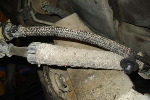The purpose of this thread is to discuss the design and possible development and installation of a supercharger for my 2000 Sport SOHC V6 engine. I have no first hand experience with forced induction systems and want to learn from forum members that have them on their vehicles. While I don't plan to implement a turbocharger system, there are many problems common to all types of forced induction systems.
The easiest and least expensive solution would be to modify a Ranger SOHC V6 Banshee kit and purchase a used Thunderbird supercoupe positive displacement blower. However, the kit makes no provisions for an aftercooler which I think is beneficial even with only 5 psi of boost.
The Explorer Express supercharger kit includes a quality looking manifold but one is very difficult to obtain.

Once again, there are no provisions for an aftercooler.
I suspect the best solution for me would be a centrifugal supercharger with a water aftercooler. With my oil coolers and remote filters I have very little room in front of the radiator for an intercooler. I am interested in a boost in the range of 5 to 8 psi - enough for a significant performance increase but not so much to adversely impact reliability and require beefing up of engine internals or the transmission/torque converter.
Procharger sells a kit for the 2005 - 2010 Mustang V6.

But the Mustang configuration is opposit to the Explorer - intake on left and battery on right. Also, there is a lot more room between the engine front and the radiator rear on the Mustang than on the Explorer.
Vortech also makes a kit for the Mustang but there are the same problems.


The logical location for a centrifugal supercharger is the same side as the air filter box and intake manifold inlet port. Unfortunately, that is where the alternator is located. I'm investigating the possibility of replacing the belt driven power steering pump with an electric motor driven pump and then relocating the alternator to the old power steering pump location.
The easiest and least expensive solution would be to modify a Ranger SOHC V6 Banshee kit and purchase a used Thunderbird supercoupe positive displacement blower. However, the kit makes no provisions for an aftercooler which I think is beneficial even with only 5 psi of boost.
The Explorer Express supercharger kit includes a quality looking manifold but one is very difficult to obtain.
Once again, there are no provisions for an aftercooler.
I suspect the best solution for me would be a centrifugal supercharger with a water aftercooler. With my oil coolers and remote filters I have very little room in front of the radiator for an intercooler. I am interested in a boost in the range of 5 to 8 psi - enough for a significant performance increase but not so much to adversely impact reliability and require beefing up of engine internals or the transmission/torque converter.
Procharger sells a kit for the 2005 - 2010 Mustang V6.
But the Mustang configuration is opposit to the Explorer - intake on left and battery on right. Also, there is a lot more room between the engine front and the radiator rear on the Mustang than on the Explorer.
Vortech also makes a kit for the Mustang but there are the same problems.
The logical location for a centrifugal supercharger is the same side as the air filter box and intake manifold inlet port. Unfortunately, that is where the alternator is located. I'm investigating the possibility of replacing the belt driven power steering pump with an electric motor driven pump and then relocating the alternator to the old power steering pump location.












